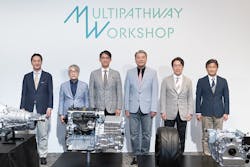Automakers Show Compact Combustion Engines Compatible with Alternative Fuels
What you'll learn:
- ICE advances made by Toyota, Subaru, and Mazda.
- How certain regulations and automaker roadmaps have changed due to slowed EV sales.
Just when it seems like electrification has pushed the internal combustion engine (ICE) to the edge of its service life, automakers find a way to make these traditional powerplants stay relevant with cleaner emissions than ever—all while consuming less fuel.
At a recent media event, Toyota, Subaru, and Mazda announced that they’re joining forces to develop new next-generation ICEs tailored for electrification, including hybrid and plug-in hybrid models, as part of their commitment to achieving carbon neutrality. Such engines will enable vehicles to carry more batteries and emit less carbon dioxide, enabling them to operate like electric vehicles most of the time while providing engine power for long-distance travel.
Achieving Carbon Neutrality with New ICEs
Described as a “multi-pathway” approach to carbon neutrality with vehicles offering a range of powertrains to be used alongside batteries, the engines will feature significantly reduced volume and height versus current engines. Each of the three companies will aim to "optimize integration with motors, batteries, and other electric drive units,” they said in a joint statement.
These efforts aren’t about extending the life of ICEs, but rather creating entirely new engines for the age of what might be called decarbonization. The new engines will be able to run with alternative fuels (biofuels such as bioethanol) as well as so-called green fuels like hydrogen, and/or get paired with zero-emissions electric motors in hybrids. By embracing these fuel options, Subaru, Toyota, and Mazda are positioning themselves at the forefront of the transition to a more sustainable automotive industry.
With Toyota owning 20% of Subaru and about 5% of Mazda, the three companies released their joint statement expressing plans for all of them to pursue the new technology. The engines being developed are designed to optimize integration with electric drive units. Such an approach makes it possible to harness the advantages offered by both conventional and electric powertrains.
Toyota’s Smaller Engines Bring Multiple Benefits
Toyota’s new engines will be between 10% and 20% smaller and will allow for greater output when paired with batteries. By making the engines more compact, the smaller engines allow for lower hoods, which improves the aerodynamic performance of vehicles as well as contributes to better fuel efficiency.
The 1.5- and 2.0-liter engines that Toyota unveiled have a volume and weight reduction of 10% compared to its existing 1.5-liter engines, with a new 2.0-liter turbo engine to see similar improvements compared to its existing 2.4-liter turbo engines. These engines comply with regulations that would require the existing model’s power to be cut by 30%. These changes are expected to yield 12% better fuel economy in sedan-class vehicles.
Subaru’s Series-Parallel Hybrid System
Subaru aims to launch a new hybrid system utilizing its horizontally opposed engine technology known as the next-generation e-Boxer. In the current e-Boxer, a parallel hybrid configuration uses both the engine and motor to power the vehicle. The new system, however, employs a series-parallel hybrid arrangement, in which the engine directly provides driving force along with better fuel economy.
Behind the horizontally opposed engine sits the differential that drives the front wheels, the hybrid unit’s twin motors and transmission, and the transfer that sends torque to the rear wheels—all housed together. Subaru’s engineers were able to mount the power-control unit, which typically takes up some of the fuel tank’s space, in the engine bay. This allows for larger tanks, ensuring the system can also compete well when it comes to cruising range
Mazda’s Rotary EV System Concept
Mazda is developing new engines based on its rotary engine design introduced more than 50 years ago. The company unveiled the single-rotor and twin-rotor Rotary EV System Concept, an electric powertrain that harnesses the strengths of rotary engines, which are compact and lightweight.
The automaker said the rotary technology will help ensure flexible vehicle development by enabling engines to burn a wide range of fuels. The single-rotor model (which is transversely mounted) is compact enough to fit straight into motor bays designed specifically for battery electric vehicles (BEVs), even when paired with electric drive units.
The longitudinally mounted twin-rotor model achieves a low center of gravity, sitting below the top of the tires on either side.
Automakers face tough emissions standards in markets such the European Union where "Euro 7" emissions rules will take effect from 2030, before a ban on sales of new CO2-emitting cars in 2035. Toyota said its new engines should go into production around the time that updated EU emission regulations are due to be phased in.
Weakening EV Sales Lead to Tactical Changes
The announcement comes as sales of fully electric cars have slowed due to concerns about costs, limited range, and insufficient charging stations. EVs also still have other weak points, such as a large amount of emissions produced while making lithium-ion batteries.
In January, Toyota Chairman Akio Toyoda said EVs would reach a global auto market share of 30% at most, with hybrids, hydrogen fuel-cell, and fuel-burning vehicles making up the rest.
Under new federal regulations unveiled Friday by the Biden administration, new vehicles sold in the U.S. will have to average about 38 miles per gallon of gasoline in 2031 in real-world driving, up from about 29 mpg this year. The new Department of Transportation rules are now significantly less than the department had proposed a year ago.
At that time, the U.S. government wanted to raise the fuel economy of new vehicles 18% by the 2032 model year so that the fleet would average about 43.5 miles per gallon in real world driving. Industry experts have estimated that the difference will cause 200 million more metric tons of carbon dioxide to be released into the atmosphere through 2050, compared with the previous plan.

